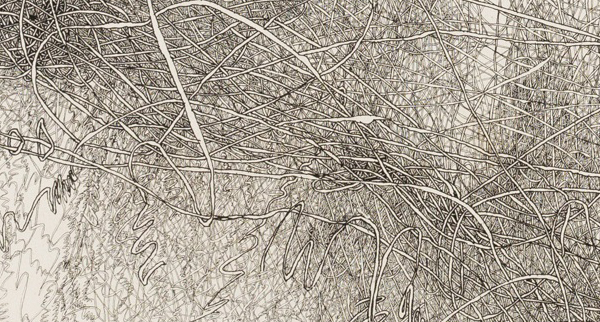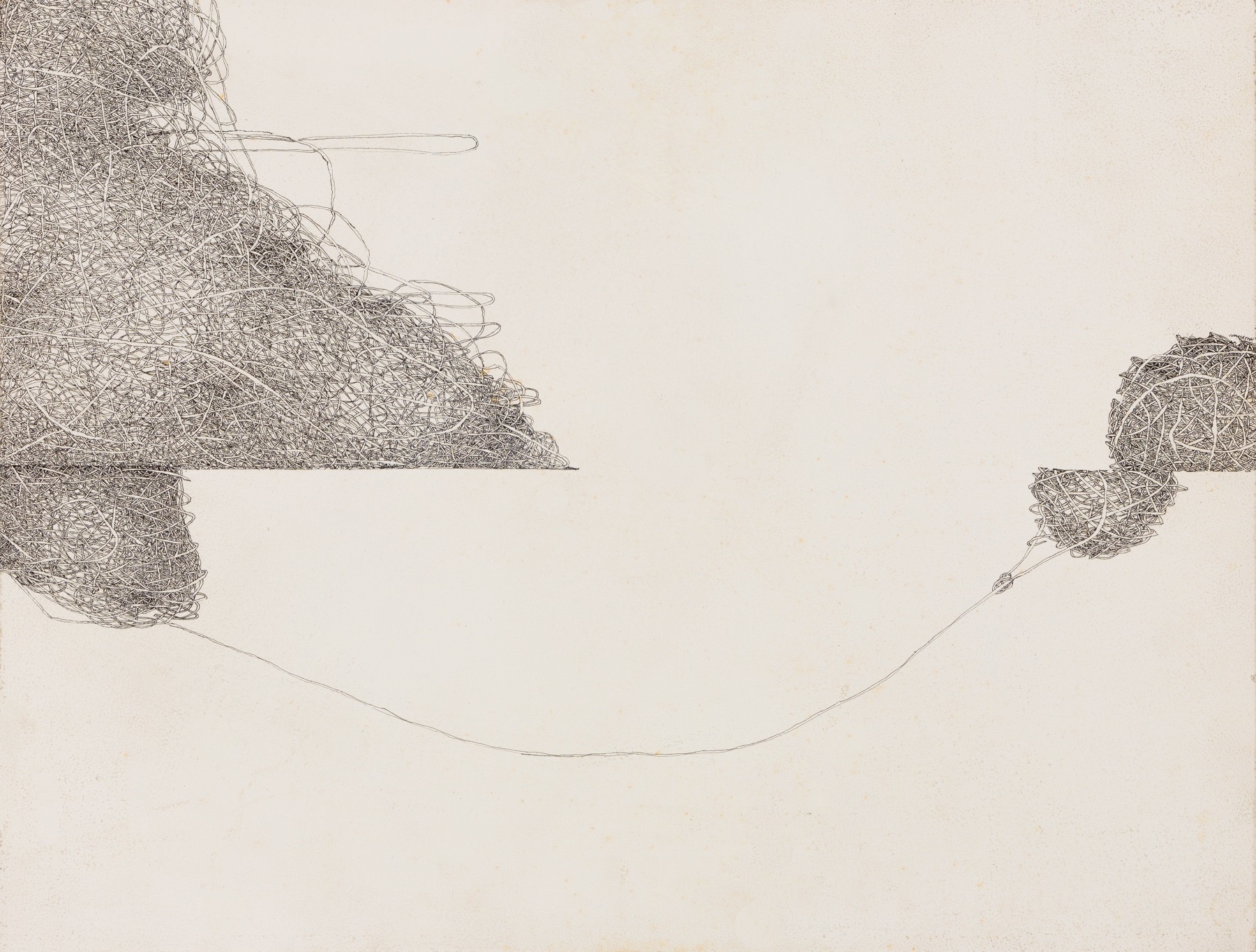The Fine Lines of Identity: Susan Hauptman's Early Works

As an artist it seems that questions often circulate regarding how much of themselves is present in their work. In many instances, it becomes difficult to decide whether the artist is able to choose exactly how much of themselves is shared with the viewer, or if self-revelation is an inevitability despite even the best attempts to keep personal connections concealed. The work of Susan Hauptman exists contentedly somewhere between these two extremes, both revealing every wrinkle and mole of her physical self by way of her meticulous self-portraits, while also including personal metaphors where the meaning for anyone else might be up to some debate. The tangible and intangible in Susan's work are given equal room, yet Hauptman was seemingly untroubled by the contradiction of the clarity of her craftsmanship and the perhaps less obvious quality of its symbolism and "meaning" for the viewer. In fact, Hauptman's early drawings which prefaced her later acclaimed self-portraits appear to revel in loose ends, literallythat which cannot be neatly rectified regardless of how clearly the artist draws it.Whether it be the components of identity, gender, memory, or relationships, Hauptman presents us with no definitive answers, no neat portrait of her holistic self, and therefore expands all possibilities and wades into the potentiality of taking up and exploring space.
Over the course of Hauptman's nearly fifty-year career, she has become renowned for her life size self-portraits done almost exclusively on paper in charcoal and pastel. The portraits are eerily realistic, drawn directly from life by way of an elaborate system of mirrors, portraying Susan either clothed in elegant attire or nude. She is generally front facing and makeup-less, with her hair cropped short. Her androgyny is undeniable, and her attire only serves to heighten this, calling into question widespread notions of gender and how masculinity and femininity are displayed and recognized. Hauptman's self-portraits are beautiful, but not due to an idealized female presence like those which have in many instances persisted throughout the history of art. Instead, there is an ethereal elegance and at times tongue in cheek amusement in Hauptman's unwavering gaze which perhaps challenged her, as much as it continues to challenge us, regarding how identity is constructed.
While Hauptman herself, or her husband Leonard in later works, often remain the central focus of her portraits, she also placed extraordinary weight on the objects that accompany them. Decadent cakes or china dolls are held or float hazily in the background and make reference to relationships to other individuals in Hauptman's life. Her still lifes furthered this tendency, each object holding a specific personal experience or memory, rather than being chosen at random. Interestingly, Hauptman treated her portraits and still lifes alike with surrealist properties; adding unique perspective techniques and dramatic shading to her personal iconography to give her drawings a dreamlike quality. She favored isometric perspective, wherein objects are represented as parallel to the viewer, while also showing certain areas from above. For example, at times we see both Susan's face, looking directly at us, while also seeing the tops of her feet. These later portraits and works reveal fully Hauptman's interest in representation and space in more figural terms, yet her fastidious and intentional distortions began far more abstracted.

Hauptman was born in Michigan in 1947. She attended the Carnegie Institute of Technology in Pittsburgh from 1965 to 1966 and finished out her BFA at the University of Michigan, Ann Arbor in 1968. Early on, Susan showed a predilection for creating figurative work, but in her formative years, she chose to exclude figures entirely in hopes of better understanding space. In 1970, Hauptman graduated from Wayne State University with her MA, and over the course of the next six years worked exclusively on ink gesso line drawings. The drawings are diligently crafted and appear less like hand drawn lines and more like delicately laid strings hanging precariously off one another. In some instances, such as Line Drawing #101, the lines act almost as thinly stretched gauze across the panel. The drawings show Hauptman's unparalleled dedication as an artist; the same scrupulous eye applied to her portraiture. There is the sense that Hauptman truly was experimenting with the series, gaining a deeper understanding of how positive and negative space interact, and the many ways through which a paper can be filled, given the variation from work to work. Her intentional manipulation of space flows seamlessly into her unusual use of perspective. Yet, as with her later figurative pieces, a key component of the line drawings seems to be that their surface aesthetic and technique is only one means by which they might be understood.

Notably in Hauptman's line drawings, each line interacts with another, hanging off dips and curves. At times, it is difficult to tell whether the drawings are caught in a state of coming together or falling apart. Masses are tethered by single threads alone, as in Line Drawing #12, and it is easy to find the clumps oddly sympathetic, as if they are in a distant, but not quite estranged relationship. The lines often become characters in and of themselves, stand ins for the complicated knots of individuals. Line Drawing #49 becomes particularly interesting when read in this manner, following one larger mass thinly tied to another across the page. They mirror each other, with their lower halves sliding to the left. The guesses to their relationship are endless; whether one is causing the other to disassemble, or the viewer is witnessing a division of a single self. Regardless, the viewer understands that things are complicated. One might easily replace the churning lines with any number of Hauptman's still life objects, or even add in Hauptman herself, and understand the same tension and interconnectedness.

Interconnectivity becomes an important point, even when the examples are perhaps not as clear cut as those mentioned above. Single masses of lines, even with no counterpart in the composition, are in a constant state of reaching out. Line Drawing #13, features a silo of lines that are gently pulled backwards, as a tendril from an unseen force stretches to meet it. Such an example embodies the idea that so much of Hauptman's work, despite how accurately she renders it, is dependent on what lies outside of the visual field. What is it that we ourselves add to Hauptman's work by observing it? What impacts perception or identity that is perhaps not readily seen? By leaving the viewer to answer many of these questions, Hauptman expands the realm of possibilities, and welcomes the viewer to explore their own space alongside her.

Perhaps above all, Hauptman's line drawings suggest change. Line Drawing #41 follows the same tangles of lines, but they seem to be undergoing a sort of mitosis. They split, and come together, gobbling up each other while sprouting new growths. Similarly, Hauptman's Untitled piece offers the same expansive, dynamic movement, beginning with tightly coiled lines that spring free across the remaining empty panel. Such exercises are certainly seen within Hauptman's later portraiture, where self-examination is anything but stagnant. Just as the linework, the body reacts accordingly to change, be it time or trauma. Experience shapes who one becomes, and Hauptman's experimental linework parallels her portraiture that feels almost like a science experiment seeking to record every stage of self, constantly reacting against variables of life.

Hauptman's series of line drawings, while certainly differing from the more well-known portraiture of her oeuvre, ultimately served as a springboard for the manner in which she explored her own identity and relationships with those around her. Undoubtedly the line drawings offered Hauptman a new means of representing objects and figures on paper, but they also presented a new way of understanding them: representing relationships, action and reaction, unreconciled loose ends, and perhaps most importantly, a comfortability with the complications and potentiality of each.

From 1976 onwards, Hauptman would move into her more acclaimed portraiture and still lifes. Her work has been featured throughout the United States at such notable institutions as the Metropolitan Museum of Art and Smithsonian National Portrait Gallery, to name only a few. She held a multitude of teaching positions, including Visiting Artist at Harvard University and the San Francisco Art Institute, as well as the Lamar Dodd Professional Chair at the University of Georgia. Susan sadly passed away on July 21, 2015, but her astounding legacy as a teacher and artist continues to be felt by those crossed her path and continue to appreciate her work.
Written by Samantha Hohmann